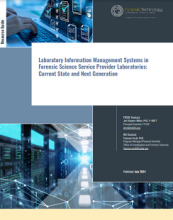Computer Systems
Automated Reporting System Pilot Project: A User's Guide to the Machine-Readable Files and Documentation, Codebook, and Original Instrument
Improving the Investigation of Violent Crime: The Homicide Investigation and Tracking System (HITS)
Project C.A.V.I.S. (Computer Assisted Voice Identification System): Final Report
Patterns of Citizen Demands for Police Service
Laboratory Information Management Systems in Forensic Science Service Provider Laboratories: Current State and Next Generation
Examining the Geographic Distribution of Victim Nations in Stolen Data Markets
The Hidden Costs of Reentry: Understanding the Barriers to Removing a Criminal Record
NIJ hosted a webinar to discuss under-researched aspects of reentry: expungement of criminal records and the impact of those records. This webinar includes a presentation of ongoing research projects examining the impact of legal aid for expungement and past research projects studying the accuracy and permanency of criminal records and the prevalence of collateral consequences of conviction. A Q&A session will conclude this webinar.
See the YouTube Terms of Service and Google Privacy Policy


